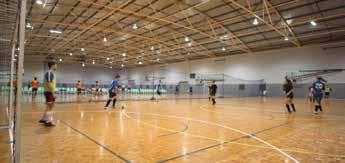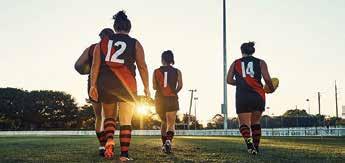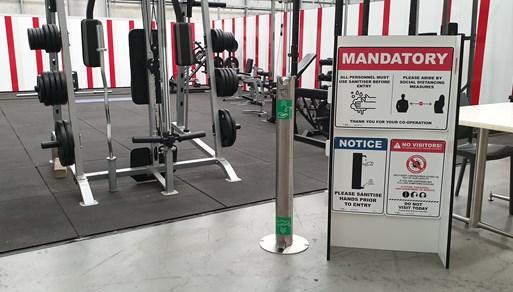
9 minute read
2020’s Crises and the Future of Sport and Recreation
2020’s Crises and the The Australian Schools Cross Country Championships, courtesy of CMS Lateral/Great Australian Cross Country Challenge.
future of Sport and Recreation
Advertisement
Martin Sheppard explores the opportunity to reform sport, make it stronger, more resilient and future proof it
The start year of a new decade normally starts with optimism, long term future plans and a renewal of energy and focus.
Yet 2020 has already presented massive challenges.
Australia has been hit with its worst ever bushfires, losing 7.7 million hectares of land (an area larger than Ireland) - with 3,000 properties burnt to the ground and 33 lives lost, resulting in an estimated $1 billion in damage.
Following this, parts of the country that had not seen rain for years celebrated rain, while the shadow of the Coronavirus outbreak began to spread, leading to the activation of the Australian Health Sector Emergency Response Plan for Novel Coronavirus (COVID-19) on 27th February.
Within weeks, the industries of community and professional sport, fitness, aquatic and recreation had been shut down while people embraced the request to ‘stay at home’ with the true Australian grit we expect.
With one of the four reasons ‘to leave home’ identified as to exercise, the positive is that across every community you see people, two by two, or families exercising together, walking, jogging or having a kick around.
But, what legacy will this create when state and territory governments loosen stay at home requests?
The Future of Sport – the Backbone of Australia
As an industry we have experienced two decades of growth in traditional sports clubs, driven by 30% population growth, set against an underlying trend (and well documented) move away from traditional sports provision.
The question now is whether changes resulting for Coronavirus closures will fast track this trend and what can we do to embrace this movement and ensure that sport as we know it also survives. The pressure on sport at all levels has already been documented during the COVID-19 Crisis with many elite sports suffering or on the verge of economic collapse with the worry of a subsequent knock on effect to community sport. Numerous commentators are asking if we are at a ‘crossroads’ for sport, whether the way Australian sport is structured is sustainable and whether multiple levels of sporting administration is too ‘heavy’ and draining.
Leaving emotion and egos to one side, we need to quickly consider how these challenges can be embraced, and how our beloved sports (and the sector) can reconnect and rebuild for the future. Why are some sports teetering on the edge, regularly staving off financial hardships and seemingly living month to month or even beyond their means? Will this year’s obligatory sign up to the National Redress Scheme mean that sport will this time fall over the edge? (The National Redress Scheme has been created in response to recommendations by the Royal Commission into Institutional Responses to Child Sexual Abuse.)
As we see Virgin Australia enter voluntary administration, with a focus on restructure and becoming more sustainable, hopefully coming out the other end a stronger and more robust organisation. Should we be establishing something like this for sport in Australia, a collaboration between sport, community
CONNECT CONVERT GROW Tasks and diaries Automated messages Lead allocation Real-time reporting. MYMEMBERSALES IS THE MOBILE-FRIENDLY LEAD MANAGAEMENT SOLUTION THAT CAN HELP YOU GROW YOUR MEMBER BASE. MyMemberSales is brought to you by Jonas Leisure. VISIT WWW.MYMEMBERSALES.COM CALL US FOR A DEMO AUS - 1300 858 840 NZ - 0508 236 826 and commercial organisations. This could mean that sport will need more entrepreneurs like NBL owner Larry Kestleman running the professional leagues, with this approach being an alternative or a vehicle to complement the ‘One Sport’ model that Sport Australia has been exploring. This could allow NSOs (national sports organisations) to refocus their roles to national team management and growing participation. This may allow the industry to rethink their funding models especially the user pay system that covers costs and how we balance that with the value we offer participants.
Once lockdowns are lifted and eased, it is to be expected that passionate sports participants will return to what they have done previously, but many may well have found other ways to exercise and stay active.
Sport may need to reinvent itself to re-attract people into sport in a manner that we have been speaking about for years, by adapting the offering to attract the broader community. Combining traditional competitive sport clubs with recreational participation has been the strategy for several years, but with limited success for NSOs. Cycling Australia’s recognition that more people cycle than compete is a great example and watching how they have established their ‘Join the Ride’ initiative could be the starting point post COVID-19 for many other sports. Why wouldn’t we expect athletics clubs to now have jogging clubs linked with weekend ‘Parkruns’? This could see the ‘joggers’ be the future volunteers for the club, possible future participants and bring much needed economic benefits. The same could be with swimming clubs, who could now offer ‘Stroke correction’ classes for lap swimmers or open water training by their coaches.
Supporting local sport will be essential as we come out of COVID-19, we are already hearing several state sports organisations (SSOs) and NSOs exploring no membership levies on participants to help in this time of hardship.

Grow your membership base Capture new leads for your business Streamline the sales journey Track your business success.

SIMPLE YET SMART

When some National Premier League football clubs charge in excess of $2,000 in annual fees for children as part of their coaching development programs, would $75 more in affiliation fees really make a difference? If there is an amnesty for the year, all levels of provision need to commit to it with a standard levy across all sport to reduce the duplication while also between states and national bodies.
This is time for radical changes, maybe an acceptance that the model we have grown up with may not be as robust and sustainable as some make out. As an industry should we be starting to rethink about how we can all work better together, all levels of government, the vertical hierarchy of sport and
UDIO IS THE CLOUD-BASED, FLEXIBLE AND EASY-TO-USE SWIM SCHOOL MANAGEMENT SOLUTION.

how can we embrace the commercial providers of activities and programs more, as people continue to find the money to receive a quality experience. Starting internally with exploring key corporate overheads that are being duplicated between the NSO and the SSOs could make a significant difference to the levels of investment into core programs throughout a sport. The idea that each state and national sports organisation should build up over the next decade a substantial war chest on their balance sheet (50% of turnover) may be a prudent start, especially if the industry could secure tax relief now to be able to future proof the sector for future generations.
Community Aquatic, Recreation and Sports Facilities
The closure of over 1000 community facilities has impacted drastically on the ability of community sport to access facilities. While local government as the key owner and their management organisations who operate these facilities on their behalf, are considering the impact on membership and facility overheads, there are a number of learnings that are emerging that need to evolve for the future.
Funding from local government to the facilities and the management models may need to be reviewed. As many local governments will be financially hurting as the year progresses; this will impact on the subsidy they pay or the level of revenue they receive for their facilities and will impact on the opening hours, the level of service and the ability to subsidise local community and sporting use may be significantly impacted. Future operational budgets could mean that the service offering needs to change.
Considerations might include whether a swimming pool should open at 6am for a handful of lap swimmers and whether a facility should stay open during the day if the cost significantly exceeds the revenue?
Now is an ideal opportunity for local government, politicians, service providers, community sport and council officers to go back to basics and ask the question, why do we have these facilities and are they really making a difference to the health and wellbeing of our community?
The impact on capital developments need to be questioned now surely. If a Council was going to invest $30 million into a second 50 metre aquatic centre, and instead invested that and received a 5% return on investment, they would receive $1.5 million per annum to invest into community physical activity and recreation programs that would encourage far more of the community to be physically active than currently participate in community sport.
The facility managers like YMCA, Belgravia Leisure, Bluefit and Aligned Leisure already have the programs for community participation and now community sport and SSO’s need to consider supporting their clubs to align with these organisations and provide these offerings themselves if they wish to stay relevant to the new post COVID-19 exercise society. Consider it as the provider of the exercise or recreational program taking the programs to the people and not expecting the people to come to their facility. Surely a better community outcome, although more challenging for traditional sports. If this is the future of sport in Australia it could also be the lifesaver with the roles that NSOs, SSOs and clubs play in the role of increasing the community to be more active.
Community sport, local government and the facility management companies can create an integrated approach with National and state governments to embrace this generational opportunity and communicate through simple campaigns for the broader community who have been exercising more during this COVID-19 close down to participate in more exercise, fitness and recreational programs as well as options for community sport. This should recognise the focus of the broader community and provide greater participation numbers for community sports clubs, program providers and community facility usage.
An integrated approach to the support and provision of community participation and sport is needed now that the sector and the families will have significantly limited resources, otherwise we will lose the opportunity that COVID -19 has provided the sector.
Martin Sheppard is Managing Director of the Smart Connection Consultancy and co-founder of the National Sports Convention, which will be relaunched at in June as three NSC – Forums, for the middle of November in Melbourne, Sydney and Brisbane, with the backing of State Governments and peak bodies.



SUPPLYING, INSTALLING & SERVICING THE BEST IN SPORTS TECHNOLOGY
NEW SURFACE AND COLOUR OPTIONS

www.sportstiming.com.au www.htsgroup.co.nz
SUPPORTING ARCHITECTS, FACILITIES & CLUBS











